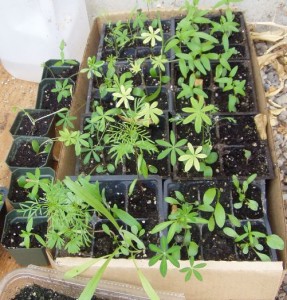 If you are the sort of person (oh, and hi again – I know I’ve been away for a while… great to be back – how are y’all? I’m fine) who at the seed rack just cannot resist those packets (or cans, or bags) of seeds labeled ‘wild flower meadow’ or ‘butterfly garden’ or that sort of thing, I’m here to tell you something important:
If you are the sort of person (oh, and hi again – I know I’ve been away for a while… great to be back – how are y’all? I’m fine) who at the seed rack just cannot resist those packets (or cans, or bags) of seeds labeled ‘wild flower meadow’ or ‘butterfly garden’ or that sort of thing, I’m here to tell you something important:
The only way those ‘by the pound’ things work is if you have at your disposal a tractor, plow, and a big tank of some sort of really strong, nasty herbicide. Basically you have to kill off everything that is living in the spot you want to plant now, which might take several applications of herbicide, and then break up the soil with the tractor and plow and broadcast the seeds. Just throwing out the seeds won’t work – the native grasses and weeds will out compete the seeds.
Not even discussing the environmental and health impacts of using those herbicides, you’re wasting money.
So, if we want to make more food for birds, butterflies and so on, what is the best way to go?
Your Aunty goes with this: Buy the smallest packet of the mixed wildflowers you can get (and there are many available, both on the seed racks and over the internet) and start them just the way you’d start any other seeds for your garden – I use the plastic salad containers from the grocery store because they come with lids and that makes keeping the moisture in easier, but whatever works for you. Once they are up and into the second leaves, I transplant them into four-packs or six-packs to really get going.
Start the seeds and when the plants are really plants, then transplant them to your garden, or to a border area.
I know some of you are saying to yourselves, “This seems like a lot of work.” It’s not really but the thing is this – if I’m going to spend my money on seeds, I want to give them the best chance at surviving and competing with the other plants out there. The best way to do that is to make sure they are already plants when I put them out in the garden. These mixes are usually made up of perennials and annuals and once the perennials are established – they have a pretty good shot at surviving through the winter and coming back next year.
A leg up, if you will, over the other weeds.
Enjoy.

I so wish I’d known this when I planted an entire package of “shade mix” in a shady border of my garden. Something came up, but I had no idea what the good plants looked like, so I let everything grow for a while and then the weeds took over. I ended up pulling everything and just buying some perennials from a big box store. Next time, though… Thank you for the tip!